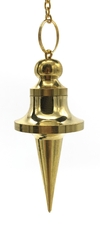The Joy of Dowsing

Dowsing is the art of finding something that is hidden, usually something concealed underground. Dowsing is most commonly used for water divining, but there appear to be virtually no limits to the number of applications it can be used for. Over the years I have dowsed for water, minerals, arrow shards, oil, lost objects, and even a parking space in the central city.
I learned how to dowse when I was ten or eleven-years-old. Every year, our family rented a holiday home at a beach resort. We were having lunch one day when a crowd of people gathered on our front lawn. We went outside to see what was going on. A man, holding a forked stick, had wandered onto our property, followed by a group of people who had no idea what he was doing. Our next-door-neighbor asked the man what he wanted. "Water," he replied. She fetched him a glass of water. This broke the man's spell. He was embarrassed, and quickly left without answering any questions. My father missed the excitement as he was out fishing. We spent all afternoon on the beach waiting for him to return home so we could tell him about the strange experience. Much to our surprise, he knew who the man was. He invited him back the next day and over the following few days the man taught almost everyone at the beach resort how to dowse.
I, and my friends, found it easy to dowse, but our parents found it much harder to get started. Of course, they had no problems either, once they had experienced the dowsing response. I have noticed over the years that children are usually better than adults at picking up skills such as dowsing, as they have yet to gain the skeptical attitudes of adulthood.
Some people are able to dowse with their hands, but most people find it easier to learn the art using angle rods, a forked stick or a pendulum. Angle rods are probably the most useful tool to start with, as the movements they create are easy to see and interpret. My first angle rods were made from two wire coat hangers, but any wire will do. You need two pieces of wire, eighteen to twenty-four inches long. Bend the wire into an L-shape. One side needs to be about six inches long, leaving twelve to eighteen inches for the longer side. The longer the long side is, the more noticeable the dowsing response will be. However, you will become tired more easily with longer rods.
Hold the angle rods loosely in your fists with the longer section of the wire pointing straight ahead. Your arms should be relaxed, and your hands should be approximately your body width apart. The two rods should be parallel to each other. It is a good idea to practice walking with the rods, so that you get used to the feel of them, before starting to dowse. Keep your eyes focussed on the tips of the rods as you walk. The rods are likely to move slightly from side to side as you do this. The dowsing response, which starts shortly before you are directly over the item you are dowsing for, is a marked and distinct movement of the rods. Your rods will cross over each other, sometimes ending up parallel to each other in front of your body.
Once you have become used to walking with the angle rods, it is time to start dowsing. A good first test is to go outdoors and use the angle rods to find the water pipe leading into your home. Think about locating the water pipe, but remain as relaxed as possible. Any tension will prevent the angle rods from moving. A few deep breaths before starting helps eliminate any tension. Start walking slowly across the front of your property. Feel confident that the angle rods will work for you, and will ultimately cross over each other, when you are directly over the pipe. If you feel skeptical about the whole process, try to suspend disbelief. The best results occur when you are quietly confident of success, and maintain a feeling of positive expectancy while you are dowsing.
If the rods produce the dowsing response by crossing over each other, make a mental note of the spot where this occurred. Keep on walking across the property, and then turn around and walk back again, this time about a yard away from where you walked before. The rods should produce the same response again when you are over the water pipe.
Many people are successful the first time they attempt this exercise. Others need to practice to achieve success. The most common problem I have found is that many people grip the wire too tightly, and this naturally prevents it from moving. If this appears to be the case, place the short sides of your angle rods inside short pieces of plastic tubing. The plastic casings from ball point pens work well for this. You can grip these as tightly as you wish, without affecting the free movement of the angle rods. Most dowsers find it hard to locate still water. Moving water is easier to detect. Consequently, if you find it hard to locate the water pipe, turn on a faucet for a couple of minutes to get the water moving.
Your first dowsing session should be no longer than thirty minutes. Several brief sessions will produce much better results than one long session. Dowsing requires concentration, and it can be draining, both mentally and physically. Once this occurs, your results will become erratic, and you will start making mistakes. Even professional dowsers pause every now and again to avoid this.
Children make excellent dowsers, but adults often make it more difficult than it should be. The best advice is to relax, and allow the dowsing response to occur. There is no need to fight, or help, the dowsing response. Relax, focus on your goal, remain slightly detached, and allow it to happen. Dowsing is a skill well worth mastering, and you will find many uses for it.

About Richard Webster
Related Products


is subject to certain Terms and Conditions